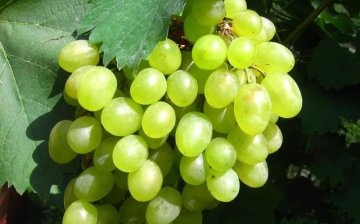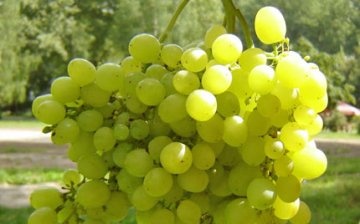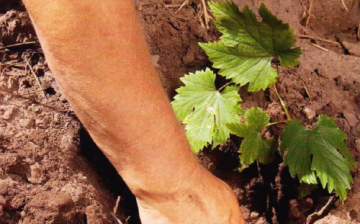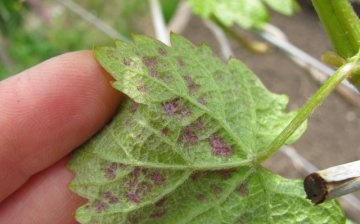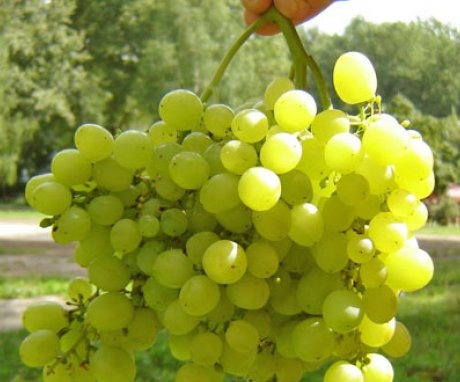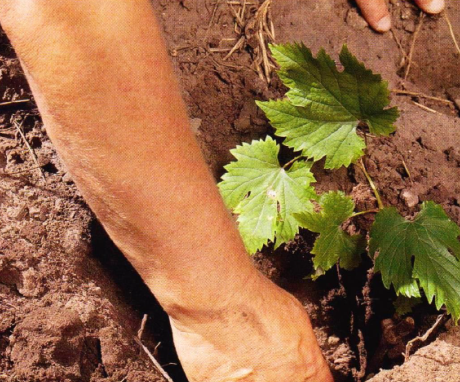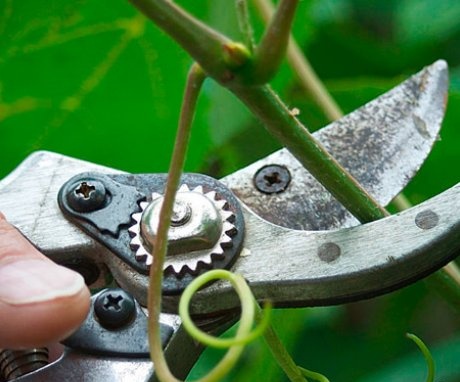Grapes "Aleshenkin" - a high-yielding table variety
One of the most beautiful decorations of the personal plot - grapes... This is not only an original solution for decorating a gazebo or arch, but also a delicious berry. In addition, the fruits of the plant are a treasure trove of vitamins and minerals. One of these interesting shrubs is the Aleshenkin grape.
Content
- Description of the grape variety, its benefits
- Reproduction and planting
- Care tips: watering, feeding and pruning
- Diseases and pests - control and prevention
Description of the grape variety, its benefits
A shrub with the Russian name "Aleshenkin" is known under the names "Alyosha Popovich" and "No. 328". In 2016, the variety celebrated its 60th anniversary. The species was grown in 1956 by the famous academician and agronomist Petr Efimovich Tsekhmistrenko. The breeder professionally bred new species of apple trees. From 1936 to 1957 he was exclusively engaged in viticulture. "Alyosha Popovich" was bred by crossing the two best grapes "Vostok" and "Marlene Angevin". The young seedling took the most original and excellent features from the parents.
The resulting type is considered a dessert table grape and is highly prized among consumers.
The bunches are made in a unique creative chaos, the berries are loosely arranged. This fragmentation allows each of the bubbles to ripen evenly and equally anywhere in the brush. The trees on the bush are voluminous, they can weigh up to 2 kg. Each of the berries in a bunch is elastic, with a delicate skin, slightly elongated to the bottom, of a pleasant amber shade. The inside of the fruit is juicy, but not cloying, with a moderate sweetness. Sugar reaches 20%, and the acidity is low - maximum 5%. The fruits are large - the weight reaches 5 g., 30 cm in diameter.
The shrub has a medium-sized leaf cover. Leaves are glossy, maple-shaped and rich green. The flowers of the vine are bisexual, a pair is not required for fertilization. Pollination is the same for all ovaries. A distinctive characteristic is the early ripening of the crop - from 90 to 120 days from the moment the buds swell. At the end of August, you can already enjoy the first harvest. Up to 25 kg are collected from one bush per season.
Main advantages:
- Grones on the vine can remain until severe frost (up to -250C).
- Resistant to long-distance transport.
- With constant care, it does not become infected with diseases and pests.
- There are 60% no seeds in the berries, and where there are - no more than 3 pcs.
The only drawback of the type is that it can grind over the years. To constantly get consistently large brushes, it is necessary to spray the vine with growth stimulants.
Thus, Aleshenkin amazes with massive bunches and early harvest. Having planted such a subspecies on the site, others can be easily abandoned.
Reproduction and planting
The shrub is tall and should be tied to a trellis. It is not recommended to plant a small stalk among the trees. At first, they will create conditions for the slow growth of the seedling, shading it, and then the long shoots will crush the growing plantings nearby.
It is better to plant the shoot on the southern or southwestern slopes, where there is a lot of sun. It will not grow on the northern and eastern sides and will wither over time. The bush does not like shade and drafts.Usually grapes are planted in open glades, observing the distance between the trellises up to 3 m.
Breeds well handle... But, there is one nuance, the most fertile grapes need to be grafted onto a winter-hardy plant, since its own roots do not tolerate even the slightest drop in temperature and immediately die. Graft on a frost-resistant variety allows you not to cover the vine even at -25 C. Planting a seedling is advised to be carried out in the warm season, after the last frost. The soil should warm up. Such measures are necessary for the young shoot to grow stronger, gain strength and successfully overwinter.
Landing features:
- The first step is to prepare the soil. A hole is dug with dimensions of 90x90x90 cm.The pit is saturated with fertile soil: 3 parts of manure and superphosphate each, mixed with the same parts wood ash and potassium salt. The deepening is poured abundantly with water, left to soften. Before the very process of moving the cutting, the soil is dug up again - they saturate the earth with oxygen.
- When planting, the seedling should be transferred from the pot with a whole lump of earth to the prepared place. The method allows you not to damage the roots, quickly adapt and grow. In addition, when planting, carefully ensure that the graft is 3 cm above the ground level, it should not be dripped in and make sure that no water gets on it. Gently tamp the soil nearby.
- The sprout is watered abundantly for 7 days. Then watering becomes moderate or even scarce. At the end of October, abundant irrigation is resumed. Before hibernation, it is more advisable to mulch the soil with straw or sawdust.
Thus, a pre-prepared planting site is a healthy, fast growth and early fruiting of a young shoot. The specific composition of the soil affects not only the amount of the crop, but also its taste.
Care tips: watering, feeding and pruning
The Aleshenkin shrub is not capricious. Like many varieties, it loves warmth and moderate watering. It bears fruit best in loose, light soils with a high nutrient content, such as black soil. It is not necessary to place seedlings on swampy areas and in a beam.
Basic care:
- Cut off excess inflorescences on top of the brush so that the rest of the berries are fully ripe.
- They are treated for parasites.
- For the winter, if necessary, carry out insulation work.
- Annual biennial pruning.
- Special watering.
Abundant irrigation of the land is necessary only during the period of berry formation. After harvest, the moisture supply is minimized. Moisturizing is renewed before winter begins. In October, watering is needed to accumulate nutrients and prepare for wintering.
The first pruning is done in April. Sick, frost-bruised and dry shoots are cut out. Vines are removed in two ways:
- Short - at the base and top of the bush, 6 buds.
- Long - shortening by 8-10 buds along all shoots.
In the middle of summer, the removal of excess vines is also carried out. When the shoot grows more than 2 m, it should be pinched at about 1.7 meters. The procedure is necessary to activate the growth of side buds for the branching of the bush. An important point for the ripening of the berries is the cut of the extra leaves that shade the bunches.
After the leaves fall in the fall, the vine is cut to form a bush. The main point, removing unnecessary stepsons, leaves a stump until the next shoot no more than 5 mm.
The plant loves feeding, in the middle of summer, liquid feeding is introduced.
The fertilizer contains superphosphate (30 g), nitromafoska (20 g), ash (50 g), manure (2 kg). All ingredients are diluted exactly in a bucket of water. After a complex addition, more fertilizers are not required. Otherwise, the first input of nutrients is carried out at the end of spring. cow dung, compost or ash... Thus, correct pruning and timely introduction of vitamins and minerals allows Alyosha to develop actively. A strong plant successfully resists any pests and pathogenic bacteria.
Diseases and pests - control and prevention
Aleshenkin grapes are not highly resistant to diseases. It is favored by various pests and actively develop at its expense, especially often exposed to fungus or powdery mildew. If you do not apply the fight against diseases, then the plant can be lost. They are treated against pests - 2 times a year and in case of urgent need.
If the grapes were sick all last year, then this year it should certainly be treated with Nitrofen solution.
Several parasites are distinguished:
- Marble mite - roots and soil around are affected. The larvae are the main danger - due to the juice of the roots, they grow and develop, increasing in number. They are collected by hand and destroyed. The soil is irrigated with Hexachloran, and then dug up.
- Fungus - when a disease is detected, the branches are sprayed several times with lime and drugs that stimulate growth.
- Oidium disease, mildew - in the first month of summer, they are treated with a mixture of chemicals. Ridomil Gold (from mildew) and Topaz (from oidium) are diluted in different containers. Both drugs are combined in one bucket, additionally pouring in Fufazon (neutralizes the spider mite). Prevention is carried out in July and October.
- Spider mite - located on the underside of a delicate leaf, feeds on juice. Withstands severe frosts, hibernates with the bush. They are processed 2 times a year (in spring and autumn) at the moment before the buds swell and after the leaves fall off. Preparations for struggle - DNOC and Nitrofen.
- Two-year-old leaf roll - if the appearance of an insect is noticed, protection from it is made in two passes, using chemicals (Biologicals, insecticides). Spraying is carried out on the swollen kidney and exactly 2 weeks after.
The fight against parasites is carried out on a calm, cloudy day. It is necessary to spray in the morning before the first rays of the sun appear. Thus, the timely detection of pathogenic creatures allows you to get rid of them in the shortest possible time and without much damage. Otherwise, it withers, the leaves take on a brown hue, the berries do not develop.
More information can be found in the video:



